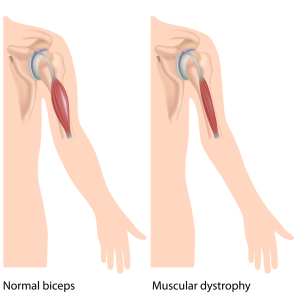There is a group of muscle diseases and disorders, which are called muscular dystrophy that are genetically transmitted.
Perhaps one of the best known muscle dystrophies is the Duchenne dystrophy, which is X-linked and recessive. It is typical for this muscle dystrophy to lead to progressive weakness in the upper arm and thigh muscles. The muscle fibers are destroyed and replaced with connective tissue.
It occurs mostly in males and affects 1 in 3000 live male births.
Symptoms
The weakness begins to show in boys starting at the age of 3 to 7 years. It progresses relentlessly with symptoms of muscle weakness and frequent falls. The pelvic muscles are affected first, but later the shoulder muscles also are affected. Difficulties are encountered walking upstairs and getting up from a sitting position.
Diagnostic Tests
Muscle biopsies for special histological studies are usually the decisive tests confirming the clinical diagnosis.
Treatment
Unfortunately there is no treatment that is effective. The prognosis is poor with most patients getting wheelchair bound by the time they are 10 to 12. The breathing muscles are eventually affected as is the heart muscle leading to premature death by the age of 18 to 20 for most patients. Patients die of lung infections, aspiration pneumonia,respiratory failure, heart arrhythmias and heart failure.
A less severe variant of muscle dystrophy is the Becker muscular dystrophy where patients may survive until the age of 35 to 40.
References
1. Goldman: Cecil Textbook of Medicine, 21st ed.,2000, W. B. Saunders Company
2. B. Sears: “The top 100 zone foods”. Regan Books, Harper Collins, 2001.
3. The Merck Manual, 7th edition, by M. H. Beers et al., Whitehouse Station, N.J., 1999. Chapter 176.
4. Noble: Textbook of Primary Care Medicine, 3rd ed.,2001, Mosby, Inc.
5. Goroll: Primary Care Medicine, 4th ed.,2000, Lippincott Williams & Wilkins
6.Rosen: Emergency Medicine: Concepts and Clinical Practice, 4th ed., 1998, Mosby-Year Book, Inc.
7. Ruddy: Kelley’s Textbook of Rheumatology, 6th ed.,2001, W. B. Saunders Company







